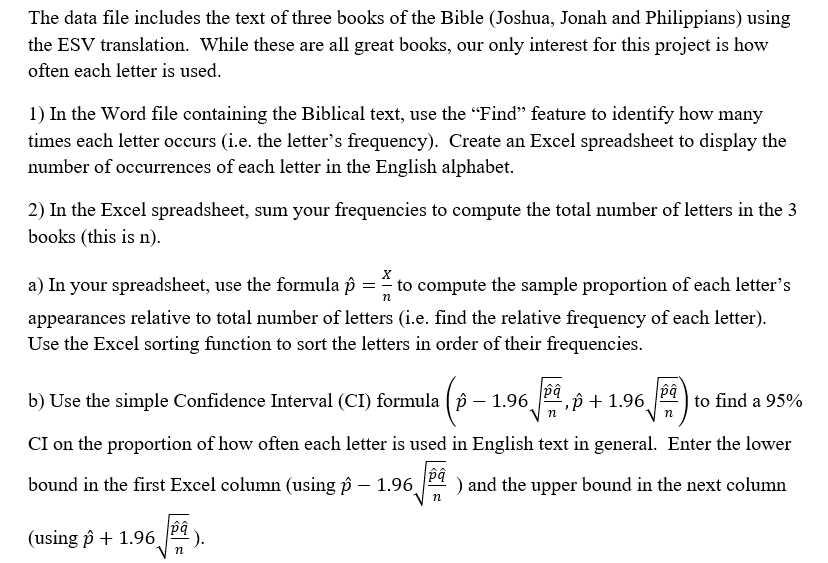The data file includes the text of three books of the Bible (Joshua, Jonah and Philippians) using the ESV translation. While these are all great books, our only interest for this project is how often each letter is used. 1) In the Word file containing the Biblical text, use the “Find” feature to identify how many times each letter occurs (i.e. the letter’s frequency). Create an Excel spreadsheet to display the number of occurrences of each letter in the English alphabet. Here is the amount of occurences I found for each letter using the find feature A=1810 B=323 C=442 D=1097 E=2845 F=609 G=416 H=1689 I=1381 J=134 K=143 L=935 M=586 N=1503 O=2237 P=379 Q=5 R=1362 S=1407 T=2235 U=703 V=257 W=513 X=17 Z=6 2) In the Excel spreadsheet, sum your frequencies to compute the total number of letters in the 3 books (this is n). a) In your spreadsheet, use the formula to compute the sample proportion of each letter’s appearances relative to total number of letters (i.e. find the relative frequency of each letter). Use the Excel sorting function to sort the letters in order of their frequencies. b) Use the simple Confidence Interval (CI) formula to find a 95% CI on the proportion of how often each letter is used in English text in general. Enter the lower bound in the first Excel column (using ) and the upper bound in the next column (using ).
The data file includes the text of three books of the Bible (Joshua, Jonah and Philippians) using the ESV translation. While these are all great books, our only interest for this project is how often each letter is used.
1) In the Word file containing the Biblical text, use the “Find” feature to identify how many times each letter occurs (i.e. the letter’s frequency). Create an Excel spreadsheet to display the number of occurrences of each letter in the English alphabet.
Here is the amount of occurences I found for each letter using the find feature
A=1810
B=323
C=442
D=1097
E=2845
F=609
G=416
H=1689
I=1381
J=134
K=143
L=935
M=586
N=1503
O=2237
P=379
Q=5
R=1362
S=1407
T=2235
U=703
V=257
W=513
X=17
Z=6
2) In the Excel spreadsheet, sum your frequencies to compute the total number of letters in the 3 books (this is n).
- a) In your spreadsheet, use the formula to compute the sample proportion of each letter’s appearances relative to total number of letters (i.e. find the relative frequency of each letter). Use the Excel sorting
function to sort the letters in order of their frequencies. - b) Use the simple Confidence Interval (CI) formula to find a 95% CI on the proportion of how often each letter is used in English text in general. Enter the lower bound in the first Excel column (using ) and the upper bound in the next column (using ).

Given information:
| A | 1810 |
| B | 323 |
| C | 442 |
| D | 1097 |
| E | 2845 |
| F | 609 |
| G | 416 |
| H | 1689 |
| I | 1381 |
| J | 134 |
| K | 143 |
| L | 935 |
| M | 586 |
| N | 1503 |
| O | 2237 |
| P | 379 |
| Q | 5 |
| R | 1362 |
| S | 1407 |
| T | 2235 |
| U | 703 |
| V | 257 |
| W | 513 |
| X | 17 |
| Z | 6 |
Trending now
This is a popular solution!
Step by step
Solved in 3 steps

I only want to know how to input the formulas into an excel spreadsheet for both step 2 and 3. Every time that I try it, it goes haywire. I know it can be done, I am just not getting it all done on the same sheet as I think I am supposed to do.
HELP






